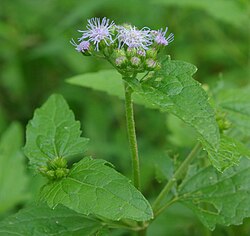From Wikipedia
Open on Wikipedia
| Conoclinium coelestinum | |
|---|---|

| |
| Scientific classification | |
| Kingdom: | Plantae |
| Clade: | Tracheophytes |
| Clade: | Angiosperms |
| Clade: | Eudicots |
| Clade: | Asterids |
| Order: | Asterales |
| Family: | Asteraceae |
| Genus: | Conoclinium |
| Species: | C. coelestinum
|
| Binomial name | |
| Conoclinium coelestinum | |
| Synonyms[1] | |
|
Synonymy
| |
Conoclinium coelestinum, commonly known as blue mistflower,[2] mistflower,[3] wild ageratum,[4] or blue boneset,[5] is a North American species of herbaceous perennial flowering plant in the family Asteraceae. It was formerly classified in the genus Eupatorium, but phylogenetic analyses in the late 20th century research indicated that that genus should be split, and the species was reclassified in Conoclinium.[6]
Description
[edit]Conoclinium coelestinum normally grows to a height of 30–76 cm (1–2.5 ft) with round, light green stems and a few or numerous branches. The leaves are opposite and ovate to triangular in shape with blunt teeth, measuring up to 8 cm (3 in) long and 5 cm (2 in) across.[7]

Flat-topped clusters, or panicles, of blue, purple, or lavender flowerheads, measuring 3–8 cm (1–3 in), are located at the end of the stems. Each flowerhead consists of about 40-50 disk florets with tiny tubular corollas that have 5 spreading lobes.[3]
Etymology
[edit]The genus Conoclinium is from the Greek word for "cone-bed". The specific epithet coelestinum is from the Latin for sky-blue or heavenly.[8]
Distribution and habitat
[edit]C. coelestinum is native to eastern and central North America, from Texas to the west, Illinois to the north, the east coast to the east, and Florida to the south. It has been introduced in New York, Michigan, and Ontario.[5] This species prefers moist soils and can be found in wood edges, sandy woodlands and clearings, wet meadows and stream banks.[9] It can thrive in a variety of light conditions ranging from shade to full sun.[10]
Ecology
[edit]The flowers bloom from July to November and are attractive to bees and butterflies.[4]
This species can grow in areas that are subject to regular prescribed fire[10] and can persist through repeated annual burning.[11]
Uses
[edit]Blue mistflower is often grown as a garden plant, although it does have a tendency to spread and take over a garden. It is recommended for habitat restoration within its native range, especially in wet soils.[9]
References
[edit]- ^ "Conoclinium coelestinum (L.) DC.". The Global Compositae Checklist (GCC) – via The Plant List. Note that this website has been superseded by World Flora Online
- ^ "USDA Plants Database". plants.usda.gov.
- ^ a b "Mistflower (Conoclinium coelestinum)". www.illinoiswildflowers.info.
- ^ a b "Lady Bird Johnson Wildflower Center - The University of Texas at Austin". www.wildflower.org.
- ^ a b "NatureServe Explorer 2.0". explorer.natureserve.org.
- ^ Schmidt, G. J.; Schilling, E. E. (2000). "Phylogeny and biogeography of Eupatorium (Asteraceae: Eupatorieae) based on nuclear ITS sequence data". American Journal of Botany. 87 (5): 716–26. doi:10.2307/2656858. JSTOR 2656858. PMID 10811796.
- ^ "Conoclinium coelestinum page". www.missouriplants.com.
- ^ Denison, Edgar (2017). Missouri Wildflowers (Sixth ed.). Conservation Commission of the State of Missouri. p. 104. ISBN 978-1-887247-59-7.
- ^ a b "Conoclinium coelestinum Blue mistflower PFAF Plant Database". pfaf.org.
- ^ a b Florida State University Robert K. Godfrey Herbarium database. URL: http://herbarium.bio.fsu.edu. Last accessed: June 2014. Collectors: Ed Keppner, Lisa Keppner, Loran C. Anderson, K. Craddock Burks, Gary R. Knight, Sidney McDaniel, Robert K. Godfrey, Richard S. Mitchell, Kurt E. Blum, J. P. Gillespie, R. Kral, C. Jackson, R. E. Perdue, Jr., James D. Ray, Jr., Olga Lakela, Gwynn W. Ramsey, Dale Samler, Ronald A. Gursell, P. L. Redfearn, Jr., Brenda Herring, Joyce Leiper, A. F. Clewell, W. G. D'Arcy, Robert L. Lazor, V. Sullivan, Bruce Hansen, JoAnn Hansen, D. C. Hunt, R. Komarek, Angela M. Reid, and K. M. Robertson. States and Counties: Florida: Bay, Brevard, Broward, Columbia, Dade, Escambia, Franklin, Gadsden, Hamilton, Holmes, Jackson, Jefferson, Leon, Levy, Liberty, Martin, Okaloosa, Sumter, Suwannee, Wakulla, and Washington. Georgia: Grady and Thomas.
- ^ Glitzenstein, J. S., D. R. Streng, R. E. Masters, K. M. Robertson and S. M. Hermann 2012. Fire-frequency effects on vegetation in north Florida pinelands: Another look at the long-term Stoddard Fire Research Plots at Tall Timbers Research Station. Forest Ecology and Management 264: 197-209.
External links
[edit]- Native Plant Database profile, Lady Bird Johnson Wildflower Center, University of Texas at Austin
- PlantFiles: Hardy Ageratum, Blue Mistflower Conoclinium coelestinum. Dave's Garden PlantFiles
 Media related to Conoclinium coelestinum at Wikimedia Commons
Media related to Conoclinium coelestinum at Wikimedia Commons
